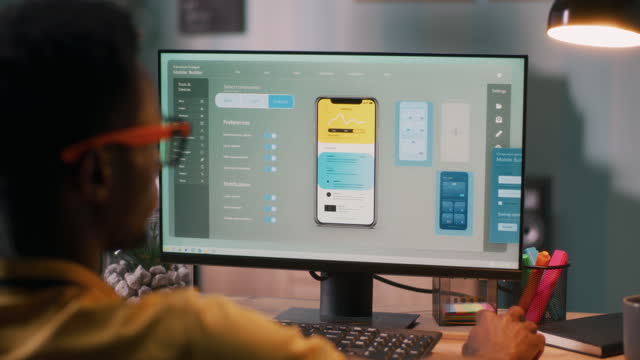We are living in the mobile-first era, with the utilization of smartphones at an all-time high. Consequently, the market for mobile apps is wide open, as almost every software company requires skilled mobile application developers. To promote their business and create brand loyalty, each and every venture seeks app developers to create interactive mobile applications.
It’s pertinent to mention, however, that developing a mobile application is not as simple as it sounds, especially if you are a beginner trying to make your name in this field. If you are looking for the best practices for mobile app development, you have come to the right place!
What is Mobile Application Development?
Mobile app development can be defined as a set of activities that are part of writing sophisticated software for mobile devices. The process of mobile app development encompasses creating applications based upon various ideas for a wide range of devices, such as smartphones, watches, and tablets. Such is the popularity of portable devices that even web developers have to ensure that the web pages adjust as per the screen sizes.
While mobile application development is also a category of software development like web development, both domains have drastic differences given the nature of portable devices. Developing mobile apps requires a basic comprehension of the smartphone’s hardware and inherent components.
Currently, two of the most prominent mobile operating systems are Android and iOS. Developing mobile apps for each platform necessitates specific skills and maintaining dedicated codebases. App development languages such as Kotlin, Java, and C# are used for developing Android apps, while Swift is the most popular choice among developers for the creation of iOS apps.
There is another peculiar category of mobile app developers that can develop applications for multiple platforms while maintaining a single codebase. They are known as cross-platform app developers who master popular frameworks like Flutter, React Native, Xamarin, etc. Cross-platform app development has significant advantages, including budget-friendliness, reduced development time, faster time to market, wider audience reach, a unified approach across several platforms, etc.
Top 10 Best Practices for Mobile App Development
According to a Statista report, the global mobile application revenue will reach $935.2 billion at the end of the fiscal year 2023. This figure underscores the potential as well as the significance of the mobile application domain.
But before diving into the development stage, it’s pertinent to identify the mistakes to avoid and know the key practices that should be kept in mind by the developer. The next section will shine a light on some of the best practices for mobile app development you must be aware of:
1) Perform Comprehensive Research
The first step in the app development approach is to conduct thorough industry research in order to increase the chances of success of your application. It is one of the most significant things to do for developing a fantastic app. First and foremost, you must identify a suitable target audience in order to get an idea of the users of your app. If you know the target audience that will download and use your app, it is bound to make your life a lot easier as a developer.
After getting an idea of the potential users of your app, the next step is to figure out how the mobile application will cater to their needs and the unique value it will offer. It’s also essential to analyze the rival apps offering similar functionalities to ensure that your application appears on the Play Store with a point of difference.

2) Identify Your Development Approach
As mentioned earlier, there are multiple ways of creating mobile applications. Not all apps are developed the same way, given the varying user requirements and budget limitations. Before initiating the development, it’s crucial to pinpoint the approach and language/framework that is ideal for the specific project.
Whether you go for native app development or a hybrid approach, the choice depends on a number of factors. If you are planning to launch the application on both Google Play Store and Apple Store, it’s better to select a hybrid framework like Flutter or React Native. This approach will save you a lot of time and expense and attract a broader audience.
If your aim is to target users of a specific platform (iOS or Android) and you also have enough budget for the project, go for a native development language like Java or C#.
The third option is to build a web app. As a mobile app developer, go with this route if you are not planning on attracting the target audience via Google Play Store or Apple Store.
3) Focus on the Design
To code the application, it’s equally important to collaborate with the design team to give priority to the visual components of the design. It is a bad approach to follow the design blindly without understanding the intricacies of the design.
Therefore, as a developer, it’s part of your job to stay in touch with the design team so that the developed product is according to the design and requirements approved by the client.
4) Prioritize User Experience
During the coding phase, you must focus on and build around the final product. Keep in mind that one day, your application could be installed on thousands or millions of smartphones. You should analyze the basic reasons why users prefer mobile applications over mobile websites and provide those functionalities in your application.
What you need to make sure of during development is to offer core features like speed, excellent user experience, ease of access, security, etc. By prioritizing user experience, you can increase the likelihood of success of your application.
5) Introduce Accessibility Features
Your target audience should include people of all ages, races, and ethnicities. As a matter of fact, it should be kept in mind that even individuals with some form of disability can download and install your app. Therefore, during the development phase, try to keep the nature of such people in mind and don’t make things difficult for them.
In order to facilitate disabled individuals, include features like voice assist, enlarged font sizes, captions, speech recognition, voice-to-text conversion, etc., in your application.
6) Plan for Scalability
Even if your application is working perfectly fine at the moment, there is always room for improvement in future updates. Some issues might arise after launching the application on the Play Store, while there is also a chance that, based on user feedback, you plan on introducing new features.
That is why you always develop your application with room for scalability. Given that your app is going to need constant monitoring and frequent updates, you should develop the application in a way that future modifications are not expensive, time-consuming, or resource-intensive.
7) Give Preference to Personalization
To ensure that your application attracts more users, you should develop it in a way that displays personalized content to everyone. By integrating analytics tools into your code, you can make analyze user’s behavior. Based on this behavior, you can make changes to your app so that each user remains attached to the app.
Another important aspect of personalization is sending push notifications to users based on their specific interests to prove that you are aware of their peculiar attractiveness.
8) Implement Robust Security Measures
It’s an undeniable fact that your application will store a lot of security-sensitive information provided by various users. That’s why you must employ stringent methods of advanced security principles to protect user data from malicious threat actors.
You should keep in mind that any form of data leak directly relates to lethal consequences, including financial loss and lack of customer trust in your brand. Hence, you should always prevent exposure of user data.
9) Choose the Ideal Monetization Model
Once your app is launched on the Google Play Store or Apple Store, you should turn your attention to the revenue stream. In the end, the purpose of developing an app is to generate revenue and that’s why it’s essential to select the monetization model wisely. Your selected monetization model will have a direct influence on how much monetary benefit you will gain as a result of the time and effort you put into the development of the app.
10) Utilize In-App Purchase Option
One of the most common categories of monetization strategies is in-app purchases, subscriptions, and in-app advertising. As a mobile application developer, you must consider defining in-app purchases for your mobile apps, as this is the best potential revenue stream for your mobile app.
The fact that most of the revenue earned by mobile application developers is through in-app purchase features underlines the significance of this monetization model, making this one of the best practices for mobile app development.
What Android and iOS Developers Should Know Before Commencing Mobile App Development?
When we talk about some of the best practices for android and iOS app development, you must realize that there are some key considerations that your app development team must keep in mind to ensure the success of your project. First, you need to clearly define the purpose and objectives of your app. Determine what core functions and features will solve a problem or add value for users.
You should also research the target audience and market landscape to ensure there is demand for such an app. Moreover, try to gain insight into user needs and preferences through surveys, interviews, or focus groups.
It’s also crucial to select the right mobile platform(s) to build for. Research whether iOS, Android, or cross-platform frameworks like React Native best suit your budget and needs. Factor in differences in user base, revenue potential, and development costs. Set realistic timelines and milestones for launch based on scope and resources. Allocate budget for ongoing maintenance and marketing to attract users.
Carefully pick appropriate tools and technologies to power your app and enhance workflows. Some of the common options include native vs. hybrid frameworks, cloud vs. local data storage, and software for prototyping, testing, and monitoring. Consider solutions to integrate with external APIs and services as well. Furthermore, prioritize employing secure data and privacy protocols from the beginning.
With diligent planning, research, and preparation on these technical and business fronts, you can set your mobile app on the path to successfully fulfilling user needs.
Key Factors of Successful Mobile Apps
Now that you have an idea of the top practices for mobile application development, every developer should know it’s time to delve deeper into this topic. The next section explores the essential factors of the most successful mobile applications:
1) User-Centric Design
Successful mobile apps prioritize user experience, offering an intuitive interface, better customer experience, easy navigation, and a pleasing visual design. User-centric design ensures engagement and satisfaction, leading to higher user retention and positive reviews.
2) Performance and Speed
A fast and responsive app is vital, given that users expect quick load times and smooth interactions. Therefore, you should optimize performance by minimizing unnecessary data requests and optimizing code.
3) Regular Updates and Maintenance
Consistent updates improve functionality, add features, and fix bugs. This shows commitment to app improvement and keeps users engaged and loyal.
4) Security and Privacy
In this day and age of technological advancements, attackers are also becoming more intelligent with every passing day. Therefore, you must put a lot of effort and resources into ensuring the protection of sensitive user data,
Protect user data and privacy and implement robust security measures to prevent breaches and unauthorized access in order to build trust among users.
5) Effective Marketing and Promotion
If no one knows about your app, what’s the outcome of all the effort and time you put into developing the application? Successful apps invest in marketing and promotion to reach their target audience. This includes app store optimization (ASO), social media campaigns, and user engagement strategies to ensure visibility and growth.
Conclusion
Mobile app development is the trending field of the modern era, with the demand for skilled app developers at an all-time high. There are certain factors that influence the success of a mobile application. This article is a comprehensive guide for every app developer, encapsulating the ideal practices for mobile app development.
At Ropstam Solutions, we have a dedicated team of mobile app developers. With more than a decade of experience in delivering quality products to our satisfied client, Ropstam is a flag-bearer in this domain. If you need any help with mobile app development projects, contact us now!














